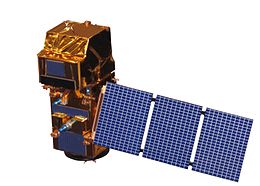 Model of a Sentinel 2 satellite | |
| Mission type | Earth observation |
|---|---|
| Operator | European Space Agency (ESA) |
| COSPAR ID | 2017-013A |
| SATCAT no. | 42063 |
| Website | Sentinel-2 (ESA) |
| Mission duration | 7 years (planned)[1] 7 years, 8 months, 20 days (elapsed) |
| Spacecraft properties | |
| Spacecraft type | Sentinel-2 |
| Manufacturer | Airbus Defence and Space |
| Launch mass | 1,140 kilograms (2,510 lb) |
| Dry mass | 1,017 kilograms (2,242 lb) |
| Dimensions | 3.4 by 1.8 by 2.35 metres (11.2 ft × 5.9 ft × 7.7 ft) |
| Power | 1700 watts |
| Start of mission | |
| Launch date | 7 March 2017, 01:49:24 UTC[2] |
| Rocket | Vega (VV-09) |
| Launch site | Kourou, SLV |
| Contractor | Arianespace |
| Orbital parameters | |
| Reference system | Geocentric orbit[3] |
| Regime | Low Earth orbit |
| Altitude | 780 km |
| Inclination | 98.56° |
| Period | 100.45 minutes |
| Transponders | |
| Band | S-band (TT&C support), X-band and optical laser through European Data Relay System (EDRS) (data acquisition) |
| Bandwidth | 64 kbit/s upload (S-band), 128 kbit/s - 2 Mbit/s download (S-band), 520 Mbit/s download (X-band / Optical) |
| Instruments | |
| Multi-Spectral Imager (MSI) | |
Sentinel-2B is a European optical imaging satellite that was launched on 7 March 2017. It is the second Sentinel-2 satellite launched as part of the European Space Agency's Copernicus Programme, and with its orbit phased 180° against its sister satellite, Sentinel-2A. The satellite carries a wide swath high-resolution multispectral imager with 13 spectral bands. It provides information for agriculture and forestry, among other services, allowing for prediction of crop yields.[4]
- ^ "Sentinel-2: The Operational Compernicus Optical High Resolution Land Mission" (PDF). European Space Agency. 2013. Retrieved 23 June 2015.
- ^ Clark, Stephen (7 March 2017). "Environmental sentinel launched from French Guiana". Spaceflight Now. Retrieved 9 March 2017.
- ^ "Sentinel 2B - Orbit". Heavens-Above. 9 March 2017. Retrieved 9 March 2017.
- ^ "Sentinel-2B Launch Preparations Off to a Flying Start". European Space Agency. 12 January 2017. Retrieved 10 March 2017.